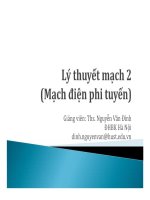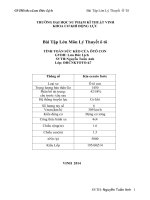Bài tập lớn Lý thuyết ô tô Đại học Bách Khoa Hà Nội
Bạn đang xem bản rút gọn của tài liệu. Xem và tải ngay bản đầy đủ của tài liệu tại đây (399.25 KB, 11 trang )
HANOI UNIVERSITY OF SCIENCE AND TECHNOLOGY
SCHOOL OF TRANSPORTATION ENGINEERING
----------*****----------
THEORY OF AUTOMOBILE
MID-TERM PROJECT
Instructor: Minh Hoang Trinh
Class’s ID: 128355
Student: Vi Van Nguyen
Student’s ID: 20186132
Hanoi, February -2022
Theory of automobile
Table of Contents
1. Build equations relating the power (𝑷𝒆) and torque of the motor (𝑻𝒆) to the
number of revolutions of the motor (𝝎𝒆) ................................................................................ 4
2. The working range when shifting gears: (𝝎𝟏,𝝎𝟐) in the power region reaching
90% PM ...................................................................................................................................... 5
3. Design a gearbox with 5 gears according to the multiplier scheme, with a straight
gear at hand 4 (n4 = 1) ............................................................................................................... 6
4. The relationship between the number of revolutions of the engine (e) - the speed
of the car (v) in each gear. ........................................................................................................ 8
5. Characterization of the relationship between traction torque (Tw) - vehicle speed
(v) in each gear........................................................................................................................... 8
6. The characteristic of traction relationship (Fx) - vehicle speed (v) in each gear ......... 9
7. Determine the acceleration time of the car from vmin= 0 to v = 100 km/h.................. 11
2
Nguyen Van Vi 20186132
Theory of automobile
Theory of automobile
Midterm exam
TT Vehicle
36 Vinfast Fadil
m (kg) Tire
1379
185/55R15
11.5 in ≈ 292,1𝑐𝑚
𝑃𝑀 (hp)
98
73 kW
𝜔𝑀 (rpm)
6200
649 rad/s
𝜂
0.9
Requirement:
1) Build equations relating the power (𝑃𝑒 ) and torque of the motor (𝑇𝑒 ) to the number of
revolutions of the motor (𝜔𝑒 ).
2) 2) Determine the working range when shifting gears: (𝜔1 , 𝜔2 ) in the power region reaching
90% PM; Plot the power characteristic (𝑃𝑒 ), torque (𝑇𝑒 ) against the number of revolutions
of the motor (𝜔𝑒 ), mark the main working area.
3) Design a gearbox with 5 gears according to the multiplier scheme, with a straight gear at
hand 4 (n4 = 1), so that the acceleration time of the car from 𝑣𝑚𝑖𝑛 to v = 100 km/h is the
3
Nguyen Van Vi 20186132
Theory of automobile
4)
5)
6)
7)
smallest. (The car's speed reaches 100 km/h in straight gear (4 th gear) at the maximum
number of revolutions 2 of the engine)
Graph the relationship between the number of revolutions of the engine (𝜔𝑒 ) - the speed of
the car (v) in each gear
Characterization of the relationship between traction torque (𝑇𝑊 ) - vehicle speed (v) in
each gear
Assuming constant rolling resistance (the maximum traction force balances the total rolling
resistance force when the vehicle is running at the maximum speed), Building the
characteristic of traction relationship (𝐹𝑥 ) - vehicle speed (v) in each gear.
Assuming that the time to first gear is ignored and the time of gear shifting operation is
ignored, determine the acceleration time of the car from 𝑣𝑚𝑖𝑛 = 0 to v = 100 km/h.
• Tire parameters: 185/55R15
-
Tire height of a tire:
ℎ𝑇 = 185 𝑥 55% = 101,75 𝑚𝑚 ≈ 4 𝑖𝑛
-
The radius of a tire 185/55R15:
𝑅𝑤 =
2ℎ𝑇 + 2𝑥4 + 15
=
= 11,5 𝑖𝑛 ≈ 292,1 𝑚𝑚
2
2
1. Build equations relating the power (𝑷𝒆) and torque of the motor (𝑻𝒆) to the number of
revolutions of the motor (𝝎𝒆)
The power of the motor is determined by the following formula:
4
Nguyen Van Vi 20186132
Theory of automobile
3
𝑃𝑒 = ∑ 𝑃𝑖 . 𝜔𝑒𝑖 = 𝑃1 . 𝜔𝑒 + 𝑃2 . 𝜔𝑒2 + 𝑃3 . 𝜔𝑒3
(3.1)
𝑖=1
𝑃1 =
𝑃𝑀
𝜔𝑀
𝑃2 =
𝑃𝑀
2
𝜔𝑀
𝑃3 = −
𝑃𝑀
3
𝜔𝑀
(3.2)
Substitude into (3.2):
73000
73000
= 112,48 (𝑊𝑠)
𝑃2 =
= 0,17331 (𝑊𝑠2 )
649
6492
73000
𝑃3 = −
= −2,67𝑥10−4 (𝑊𝑠3 )
6493
𝑃1 =
3
𝑃𝑒 = 112,48𝜔𝑒 + 0,17331𝜔𝑒 2 − 2,67𝑥 10−4 𝜔𝑒 (W)
-
The torque of the motor is determined by the following formula:
𝑇𝑒 =
𝑃𝑒
= 𝑃1 + 𝑃2 . 𝜔𝑒 + 𝑃3 . 𝜔𝑒2
𝜔𝑒
(3.5)
Substitute into (3.5), the torque performance equation:
𝑇𝑒 = 112,48 + 0,17331𝜔𝑒 − 2,67𝑥10−4 𝜔𝑒
2
2. The working range when shifting gears: (𝝎𝟏,𝝎𝟐) in the power region reaching 90% PM
From equation (3.1), with P = 90%.PM = 73 (kW), the range of revolution
allowed to reach this power is from 494 rad/s (≈ 4717 rpm) to 787 rad/s (≈ 7515 rpm)
3
𝑃𝑒 = 112,48𝜔𝑒 + 0,17331𝜔𝑒 2 − 2,67𝑥 10−4 𝜔𝑒 = 65700 W
1 = 494 rad/s; 2 = 787 rad/s
Substitute e = 0 to 900 rad/s, we can draw power characteristic graphs (Pe), torque (Te)
against the number of revolutions of the motor (we), mark the main working of the engine
in the figure 1.
5
Nguyen Van Vi 20186132
Theory of automobile
Figure 1: . Engine’s external characteristics
3. Design a gearbox with 5 gears according to the multiplier scheme, with a straight gear
at hand 4 (n4 = 1)
Determine the gear ratio of the main transmission nd:
According to the problem, the car speed reaches 100km/h (27.78 m/s) at the straight gear
(number 4) at the maximum number of revolutions we of the engine, we have:
𝑣4𝑚𝑎𝑥 =
𝑅𝑤 𝜔2
𝑅𝑤 𝜔2 0,292 ∗ 787
⇒ 𝑛𝑑 =
=
= 8,272
𝑛𝑑
𝑣4𝑚𝑎𝑥
27,78
Determine the gear ratio in the gears:
The relationship between the number of engine revolutions and the speed in the ith gear
according to the formula:
𝜔𝑒 =
𝑛𝑖 𝑛𝑑
𝑅𝑤 𝜔𝑒
𝑅𝑤 𝜔𝑒
𝑣𝑥 ⇒ 𝑣𝑥 =
; 𝑛𝑖 =
𝑅𝑤
𝑛𝑖 𝑛𝑑
𝑣𝑥 𝑛𝑑
6
Nguyen Van Vi 20186132
Theory of automobile
• At vx = 27.78 m/s, e = 2 = 787 rad/s, the gearbox operates in number 4: n4 = 1
At the 4th gear:
𝑣𝑥,4 =
𝑅𝑤 𝜔𝑒
𝑛4 𝑛𝑑
At e = 2 = 787 rad/s, we have: 𝑣𝑥,4 =
=
𝑅𝑤 𝜔𝑒
𝑛4 𝑛 𝑑
𝑅𝑤 𝜔𝑒
𝑛𝑑
=
(4*)
𝑅𝑤 𝜔𝑒
𝑛𝑑
=
0.292∗494
8,272
= 17,438 𝑚/𝑠
The gearbox shifts to 3rd gear, the engine jumps to the high revolution e = 2 = 787
rad/s
𝑛3 =
We have:
𝑅𝑤 𝜔2
𝑣𝑥 𝑛𝑑
0.292∗787
= 17.438∗8.272 = 1,5931
• At the 3rd gear:
𝑣𝑥,3 =
𝑅𝑤 𝜔𝑒
𝑛 3 𝑛𝑑
=
𝑅𝑤 𝜔𝑒
1,5931∗𝑛𝑑
(3*)
𝑅 𝜔
𝑅 𝜔
0,292∗494
𝑤 𝑒
At e = 1 = 494 rad/s, at the 3rd gear => vx,3 = 𝑛𝑤𝑛 𝑒 = 1,5929∗𝑛
= 1,5931∗8,272 = 10,946 𝑚/𝑠
3 𝑑
𝑑
The gearbox shifts to 2nd gear, the engine jumps to the high revolution e = 2 = 787
rad/s
We have: 𝑛2 =
𝑅𝑤 𝜔2
𝑣𝑥 𝑛𝑑
0,292∗787
= 10,946∗8.272 = 2.538
• At the 2nd gear:
𝑣𝑥,2 =
𝑅𝑤 𝜔𝑒
𝑛2 𝑛𝑑
𝑅 𝜔
𝑤 𝑒
= 2,538∗𝑛
(2*)
𝑑
At e = 1 = 494 rad/s, ở tay số 2 => vx,2 = 6.87 m/s.
The gearbox shifts to 1st gear, the engine jumps to the high revolution: e = 2 = 787 rad/s
We have:
𝑛1 =
•
𝑅𝑤 𝜔2 0,292 ∗ 787
=
= 4.044
𝑣𝑥 𝑛𝑑
6,87 ∗ 8,272
At the 1st gear:
𝑣𝑥,1 =
𝑅𝑤 𝜔𝑒
𝑛1 𝑛𝑑
𝑅 𝜔
𝑤 𝑒
= 4,044𝑛
𝑑
(1*)
At e = 1 = 494 rad/s, => vx,1 = 4,312 m/s.
The 5th gear at e = 1 = 494 rad/s
𝑛5 =
Nguyen Van Vi 20186132
𝑅𝑤 𝜔𝑒
0,292 ∗ 494
=
= 0.628
𝑣𝑥 𝑛𝑑
27,78 ∗ 8,272
7
Theory of automobile
At e = 1 = 494 rad/s: 𝑣𝑥,5 =
𝑅𝑤 𝜔𝑒
𝑛5 𝑛𝑑
𝑅 𝜔
𝑤 𝑒
= 0,628∗𝑛
= 27,78 (m/s) (5*)
𝑑
So, the gear ratio of the gearbox:
n1 = 4,044; n2 = 2,538; n3 = 1,5931; n4 = 1; n5 = 0,628.
4. The relationship between the number of revolutions of the engine (e) - the speed of the
car (v) in each gear.
Figure 2: . The relationship between the number of revolutions and the speed
From equations (1*), (2*), (3*), (4*) and (5*), we can draw graphs of the relationship
between the number of revolutions of the engine (e) and the speed of the car in each
gear. (Substitute with e = 0 to 900 rad/s).
5. Characterization of the relationship between traction torque (Tw) - vehicle speed (v) in
each gear
Traction torque (Tw) in each gear is calculated according to the formula (3.59) with the
velocity relationship vx in each gear (i = 1, 2...,5):
𝑃
𝑃
𝑇w,𝑖 = 𝜂𝑃1 𝑛𝑑 𝑛𝑖 + 𝜂 𝑅2 𝑛𝑑2 𝑛𝑖2 𝑣𝑥 + 𝜂 𝑅23 𝑛𝑑3 𝑛𝑖3 𝑣𝑥2 (3.59)
𝑤
𝑤
• At n1 = 4,044; vx,1 = 4,312 m/s
8
Nguyen Van Vi 20186132
Theory of automobile
𝑃
𝑃
2
𝑇w,1 = 𝜂𝑃1 𝑛𝑑 𝑛1 + 𝜂 𝑅 2 𝑛𝑑2 𝑛12 𝑣𝑥,1 + 𝜂 𝑅32 𝑛𝑑3 𝑛13 𝑣𝑥,1
= 4002 (Nm)
𝑤
𝑤
• At n2 = 2,538; vx,2 = 6,87 m/s
𝑃
𝑃
2
𝑇w,2 = 𝜂𝑃1 𝑛𝑑 𝑛2 + 𝜂 𝑅2 𝑛𝑑2 𝑛22 𝑣𝑥,2 + 𝜂 𝑅23 𝑛𝑑3 𝑛23 𝑣𝑥,2
= 2512 (Nm)
𝑤
𝑤
• At n3 = 1,5931; vx,3 = 10,946 m/s
𝑃
𝑃
2
𝑇w,3 = 𝜂𝑃1 𝑛𝑑 𝑛3 + 𝜂 𝑅2 𝑛𝑑2 𝑛32 𝑣𝑥,3 + 𝜂 𝑅32 𝑛𝑑3 𝑛33 𝑣𝑥,3
= 1576 (Nm)
𝑤
𝑤
𝑃
𝑃
• At n4 = 1; vx,4 = 17,438 m/s
2
𝑇w,4 = 𝜂𝑃1 𝑛𝑑 𝑛4 + 𝜂 𝑅2 𝑛𝑑2 𝑛42 𝑣𝑥,4 + 𝜂 𝑅23 𝑛𝑑3 𝑛43 𝑣𝑥,4
= 990 (Nm)
𝑤
𝑤
• At n5 = 0,628; vx,5 = 27,78 m/s
𝑃
𝑃
2
𝑇w,5 = 𝜂𝑃1 𝑛𝑑 𝑛5 + 𝜂 𝑅2 𝑛𝑑2 𝑛52 𝑣𝑥,5 + 𝜂 𝑅23 𝑛𝑑3 𝑛53 𝑣𝑥,5
= 621 (Nm)
𝑤
𝑤
Combined with the values vx,i (the formulas (1*), (2*) to (5*) above), we can draw the
characteristic lines of the drag torque (Tw) - car speed (v) in each gear.
The relationship between traction tourue - speed at each gear
6000
Tw (Nm)
5000
4000
3000
2000
1000
0
0.00
5.00
10.00
15.00
20.00
25.00
30.00
35.00
40.00
45.00
50.00
vx (m/s)
Tw1
Tw2
Tw3
Tw4
Tw5
Figure 3:The relationship between traction torque - vehicle speed
6.
The characteristic of traction relationship (Fx) - vehicle speed (v) in each gear
Traction at the active wheel in each gear is determined by the formula:
Fx,i =
Tw,i
Rw
(3.51)
Combining formula (3.59), we have:
9
Nguyen Van Vi 20186132
Theory of automobile
𝐹x,𝑖 =
𝑇w,𝑖
=
𝑅𝑤
𝜂𝑃1 𝑛𝑑 𝑛𝑖
𝑅𝑤
𝑃
𝑃
+ 𝜂 𝑅22 𝑛𝑑2 𝑛𝑖2 𝑣𝑥 + 𝜂 𝑅33 𝑛𝑑3 𝑛𝑖3 𝑣𝑥2 (6*)
𝑤
𝑤
Substitude into (6*) we have:
𝐹x,1 =
𝜂𝑃1 𝑛𝑑 𝑛1
𝑃2
𝑃3
+ 𝜂 2 𝑛𝑑2 𝑛12 𝑣𝑥 + 𝜂 3 𝑛𝑑3 𝑛13 𝑣𝑥2 = 11597,3 + 2047𝑣𝑥 − 361,3𝑣𝑥2
𝑅𝑤
𝑅𝑤
𝑅𝑤
𝜂𝑃1 𝑛𝑑 𝑛2
𝐹x,2 =
𝑅𝑤
𝐹x,3 =
𝐹x,4 =
𝑃
𝑤
𝜂𝑃1 𝑛𝑑 𝑛3
𝑅𝑤
𝑃
+ 𝜂 𝑅22 𝑛𝑑2 𝑛22 𝑣𝑥 + 𝜂 𝑅33 𝑛𝑑3 𝑛23 𝑣𝑥2 = 7278,4 + 806,3𝑣𝑥 − 89,3𝑣𝑥2
𝑤
𝑃
𝑃
+ 𝜂 𝑅22 𝑛𝑑2 𝑛32 𝑣𝑥 + 𝜂 𝑅33 𝑛𝑑3 𝑛33 𝑣𝑥2 = 4568,6 + 317,7𝑣𝑥 − 22,1𝑣𝑥2
𝑤
𝑤
𝜂𝑃1 𝑛𝑑 𝑛4
𝑃2
𝑃3
+ 𝜂 2 𝑛𝑑2 𝑛42 𝑣𝑥 + 𝜂 3 𝑛𝑑3 𝑛43 𝑣𝑥2 = 2867,8 + 125,2𝑣𝑥 − 5,5𝑣𝑥2
𝑅𝑤
𝑅𝑤
𝑅𝑤
Combined with the values vx,i (formulas (1*), (2*) to (5*) above), it is possible to draw
characteristic lines of tractionv force (Fx) - vehicle speed (v) in each gear.
The relationship between traction force - speed at each gear
16000.0
14000.0
Fx (N)
12000.0
10000.0
8000.0
6000.0
4000.0
2000.0
0.0
0.00
5.00
10.00
15.00
20.00
25.00
30.00
35.00
40.00
vx (m/s)
Fx1
Fx2
Fx3
Fx4
Fx5
Figure 4:. The relationship between traction force - vehicle speed
10
Nguyen Van Vi 20186132
45.00
50.00
Theory of automobile
7. Determine the acceleration time of the car from vmin= 0 to v = 100 km/h
At vxmax, ni = n5:
𝐹𝑅 = 𝐹𝑥 = 𝜂
𝑛𝑖 𝑛𝑑 𝑃𝑒
𝑅𝑤 𝜔𝑒
= 0.9 ∗
0,628∗8,272
0.292
65,7
∗ 787 = 1,336(𝑘𝑁) = 1336(𝑁)
• Acceleration time from v = 0 to v = 6,87 m/s (tay số 1): m=1379 kg
6,87
𝑡1 = 𝑚 ∫
0
1
𝑑𝑣 = 0,83𝑠
𝐹𝑥,1 − 𝐹𝑅 𝑥
• Acceleration time from v = 6,87 to v = 10,946 m/s (tay số 2):
10,946
𝑡2 = 𝑚 ∫6,87
1
𝐹𝑥,2 −𝐹𝑅
𝑑𝑣𝑥 = 0,976𝑠
• Acceleration time from v = 10,946 to v = 17,438 m/s (tay số 3):
17,438
𝑡3 = 𝑚 ∫
10,946
1
𝑑𝑣 = 2,89𝑠
𝐹𝑥,3 − 𝐹𝑅 𝑥
• Acceleration time from v = 17,438 to v = 27,78 m/s (100 km/h) (tay số 4):
27,78
1
𝑑𝑣𝑥 = 10,21𝑠
17,438 𝐹𝑥,4 − 𝐹𝑅
𝑡4 = 𝑚 ∫
• Total acceleration time from 0 đến 100 km/h:
𝑡 = 𝑡1 + 𝑡2 + 𝑡3 + 𝑡4 = 14,906(𝑠)
11
Nguyen Van Vi 20186132









